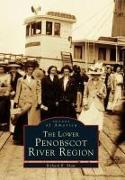The Lower Penobscot River region has long lured vacationers and mariners alike, entranced by the natural beauty of the "Rhine of Maine." Early sailors named this nearly 30-mile stretch of the mighty river "Bangor River," since Bangor, the great nineteenth-century lumbering port, was the head of navigation for their schooners, barks, and brigs, laden with dry cargo, rum, and ice. Eleven historic towns line the Lower Penobscot: Searsport, Stockton Springs, Prospect, Verona, Bucksport, Frankfort, Winterport, Hampden, Orrington, Brewer, and Bangor. All are represented here with vivid photographs dating from the 1860s to the present. We journey to a time when ice harvesting was an important industry, and we see pleasure boats, town squares, and tidy shuttered cottages and hotels. Bangor and Brewer are especially highlighted with images of their ice sheds, shipyards, and once-bustling downtowns. We visit old Fort Knox, a never-completed fortress made of Maine granite, and Waldo-Hancock Bridge, a 1931 engineering marvel linking Prospect, Verona, and Bucksport via Route 1.


